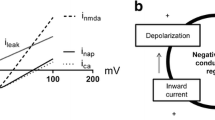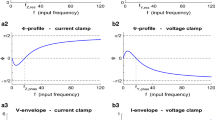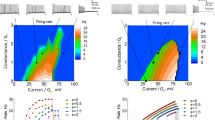Abstract
We present a technique which combines two methods in order to measure the series resistance (R S) during whole-cell patch-clamp recordings from excitable and non-excitable cells. R S is determined in the amplifier’s current-clamp mode by means of an active bridge circuit. The correct neutralization of the electrode capacitance and the adjustment of the bridge circuit is achieved by the so-called phase-sensitive method: Short sine wave currents with frequencies between 3 and 7 kHz are injected into the cells. Complete capacitance neutralization is indicated by the disappearance of the phase lag between current and voltage, and correct bridge balance is indicated by a minimized voltage response to the sine wave current. The R S value determined in the current-clamp mode then provides the basis for R S compensation in the voltage-clamp recording mode. The accuracy of the procedure has been confirmed on single-compartment cell models where the error amounted to 2–3 %. Similar errors were observed during dual patch clamp recordings from single neocortical layer 5 pyramidal cells where one electrode was connected to the bridge amplifier and the other one to a time-sharing, single-electrode current- and voltage-clamp amplifier with negligible R S. The technique presented here allows R S compensation for up to 80–90 %, even in cells with low input resistances (e.g., astrocytes). In addition, the present study underlines the importance of correct R S compensation by showing that significant series resistances directly affect the determination of membrane conductances as well as the kinetic properties of spontaneous synaptic currents with small amplitudes.









Similar content being viewed by others
References
Armstrong CM, Chow RH (1987) Supercharging: a method for improving patch-clamp performance. Biophys J 52:133–136. doi:10.1016/S0006-3495(87)83198-3
Armstrong CM, Gilly WF (1992) Access resistance and space clamp problems associated with whole-cell patch clamping. In: Rudy B, Iverson LE (eds) Methods in enzymology, Ion channels, vol 207. Academic Press, San Diego, pp. 100–122. doi:10.1016/0076-6879(92)07007-B
Bar-Yehuda D, Korngreen A (2008) Space-clamp problems when voltage clamping neurons expressing voltage-gated conductances. J Neurophysiol 99:1127–1136. doi:10.1152/jn.01232.2007
Binstock L, Adelman WJ Jr, Senft JP, Lecar H (1975) Determination of the resistance in series with the membranes of giant axons. J Membrane Biol 21:25–47
Brette R, Piwkowska Z, Rudolph M, Bal T, Destexhe A (2007) A non-parametric electrode model for intracellular recording. Neurocomputing 70:1597–1601. doi:10.1016/j.neucom.2006.10.039
Brette R, Piwkowska Z, Monier C, Rudolph-Lilith M, Fournier J, Levy M, Frégnac Y, Bal T, Destexhe A (2008) High-resolution intracellular recordings using a real-time computational model of the electrode. Neuron 59:379–391. doi:10.1016/j.neuron.2008.06.021
de Sa VR, MacKay DJC (2001) Model fitting as an aid to bridge balancing in neuronal recording. Neurocomputing 38-40:1651–1656. doi:10.1016/S0925-2312(01)00525-2
Engel E, Barcilon V, Eisenberg RS (1972) The interpretation of current-voltage relations recorded from a spherical cell with a single microelectrode. Biophys J 12:384–403. doi:10.1016/S0006-3495(72)86091-0
Golowasch J, Thomas G, Taylor AL, Patel A, Pineda A, Khalil C, Nadim F (2009) Membrane capacitance measurements revisited: dependence of capacitance value on measurement method in nonisopotential neurons. J Neurophysiol 102:2161–2175. doi:10.1152/jn.00160.2009
Hutcheon B, Yarom Y (2000) Resonance, oscillation and the intrinsic frequency preferences of neurons. Trends Neurosci 23:216–222. doi:10.1016/S0166-2236(00)01547-2
Ito M (1957) The electrical activity of spinal ganglion cells investigated with intracellular microelectrodes. Jap J Physiol 7:297–323
Major G (1993) Solutions for transients in arbitrarily branching cables: III. Voltage clamp problems. Biophys J 65:469–491. doi:10.1016/S0006-3495(93)81039-7
Marty A, Neher E (1995) Tight-seal whole-cell recording. In: Sakmann B, Neher E (eds) Single channel recording, 2nd edn. Plenum Press, NewYork and London, pp. 31–52
Moore JW, Hines M, Harris EM (1984) Compensation for resistance in series with excitable membranes. Biophys J 46:507–514. doi:10.1016/S0006-3495(84)84048-5
Nadeau H, Lester HA (2000) Two-compartment model for whole-cell data analysis and transient compensation. J Neurosci Meth 99:25–35. doi:10.1016/S0165-0270(00)00210-7
Oliva AA Jr, Jiang M, Lam T, Smith KL, Swann JW (2006) Novel hippocampal interneuronal subtypes identified using transgenic mice that express green fluorescent protein in GABAergic interneurons. J Neurosci 20:3354–3368
Pandey S, White MH (2002) Parameter-extraction of a two-compartment model for whole-cell data analysis. J Neurosci Meth 120:131–143. doi:10.1016/S0165-0270(02)00198-X
Park MR, Kita H, Klee MR, Oomura Y (1983) Bridge balance in intracellular recording: introduction of the phase-sensitive method. J Neurosci Meth 8:105–125. doi:10.1016/0165-0270(83)90112-7
Poleg-Polsky A, Diamond JS (2011) Imperfect space clamp permits electrotonic interactions between inhibitory and excitatory synaptic conductances, distorting voltage clamp recordings. PLoS One 6:e19463. doi:10.1371/journal.pone0019463
Rossant C, Fontaine B, Magnusson AK, Brette R (2012) A calibration-free electrode compensation method. J Neurophysiol 108:2629–2639. doi:10.1152/jn.01122.2011
Sala F, Sala S (1994) Sources of errors in different single-electrode voltage-clamp techniques: a computer simulation study. J Neurosci Meth 53:189–197. doi:10.1016/0165-0270(94)90176-7
Sherman AJ, Shrier A, Cooper E (1999) Series resistance compensation for whole-cell patch-clamp studies using a membrane state estimator. Biophys J 77:2590–2601. doi:10.1016/S0006-3495(99)77093-1
Sigworth FJ (1995) Electronic design of the patch clamp. In: Sakmann B, Neher E (eds) Single channel recording, 2nd edn. Plenum Press, NewYork and London, pp. 95–128
Strickholm A (1995) A single electrode voltage, current- and patch-clamp amplifier with complete stable series resistance compensation. J Neurosci Meth 61:53–66. doi:10.1016/0165-0270(95)00021-L
Sutor B, Grimm C, Polder HR (2003) Voltage-clamp-controlled current-clamp recordings from neurons: an electrophysiological technique enabling the detection of fast potential changes at preset holding potentials. Pflügers Arch – Eur J Physiol 446:133–141. doi:10.1007/s00424-003-1008-0
Taylor AL (2012) What we talk about when we talk about capacitance measured with the voltage-clamp step method. J Comput Neurosci 32:167–175. doi:10.1007/s10827-011-0346-8
Taylor JR (1997) An introduction to error analysis. University Science Books, Sausalito
Traynelis SF (1998) Software-based correction of single compartment series resistance errors. J Neurosci Meth 86:25–34. doi:10.1016/S0165-0270(98)00140-X
White WE, Hooper SL (2013) Contamination of current-clamp measurement of neuron capacitance by voltage-dependent phenomena. J Neurophysiol 110:257–268. doi:10.1152/jn.00993.2012
Williams SR, Mitchell SJ (2008) Direct measurement of somatic voltage clamp errors in central neurons. Nature Neurosci 11:790–798. doi:10.1038/nn.2137
Wilson CJ, Park MR (1989) Capacitance compensation and bridge balance adjustment in intracellular recording from dendritic neurons. J Neurosci Meth 27:51–75. doi:10.1016/0165-0270(89)90052-6
Zhou L, Sun B, Zhang CL, Fine A, Chiu SY, Messing A (1997) Live astrocytes visualized by green fluorescent protein in transgenic mice. Dev Biol 187:36–42. doi:10.1006/dbio.1997.8601
Zolles G, Wagner E, Lampert A, Sutor B (2009) Functional expression of nicotinic acetylcholine receptors in rat neocortical layer 5 pyramidal cells. Cereb Cortex 19:1079–1091. doi:10.1093/cercor/bhn158
Acknowledgments
We thank F. Rucker for mathematical support, G. Horn for technical assistance, R. Kurtz for valuable comments on the manuscript, and M. Sutor-Gauß for editing the manuscript.
BS would like to dedicate this manuscript to the 80th birthday of Prof. Dr. Gerrit ten Bruggencate.
Author information
Authors and Affiliations
Corresponding author
Ethics declarations
Conflicts of interest
HRP is an employee of npi electronic GmbH. TR and BS declare no conflicts of interest.
Electronic supplementary material
ESM 1
(PDF 448 kb)
Rights and permissions
About this article
Cite this article
Riedemann, T., Polder, H.R. & Sutor, B. Determination and compensation of series resistances during whole-cell patch-clamp recordings using an active bridge circuit and the phase-sensitive technique. Pflugers Arch - Eur J Physiol 468, 1725–1740 (2016). https://doi.org/10.1007/s00424-016-1868-8
Received:
Revised:
Accepted:
Published:
Issue Date:
DOI: https://doi.org/10.1007/s00424-016-1868-8




